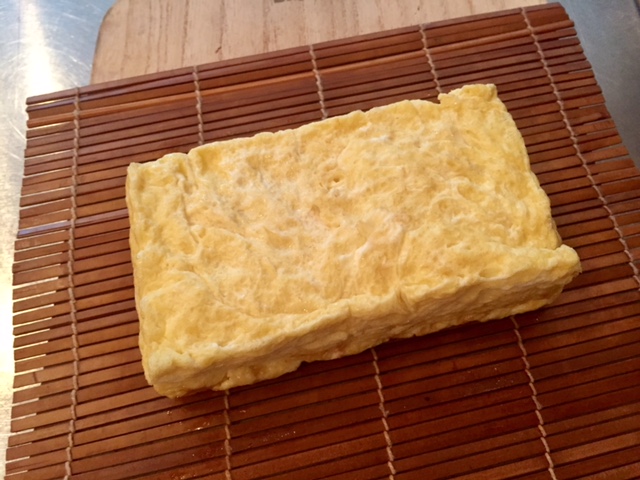 For the first time I made a true dashimaki tamago from the point of ingredients in my kitchen. This is quite different from the tamagoyaki I have been making for years. I am from Tokyo, the heart of the Kanto region, and recently have become quite curious about making Kyoto style dashimaki tamago. I swear that up to this day I had never made it in my kitchen, and now I have.
For the first time I made a true dashimaki tamago from the point of ingredients in my kitchen. This is quite different from the tamagoyaki I have been making for years. I am from Tokyo, the heart of the Kanto region, and recently have become quite curious about making Kyoto style dashimaki tamago. I swear that up to this day I had never made it in my kitchen, and now I have.
Tamagoyaki, rolled egg omelet, has many associated stories for me. In my early years at elementary school, my mother prepared tamagoyaki, cut it into slices and packed them in my sisters’ and my lunch boxes. Bright yellow, sweet and juicy tamagoyaki, even though cold when I ate it at lunch, cheered me up every day. Tamagoyaki is still everyone’s favorite item and nearly always a part of casual and more formal obento boxes. This includes the lunch box that you can purchase at train station for enjoyment on a long distance train ride. Tamagoyaki also plays an important role at sushi restaurants. At casual sushi restaurants if you order “tamago” – egg – you will likely be given a piece of tamagoyaki. In contrast if you order “tamago” at a high-end sushi restaurant you will receive a different dish, an egg sponge cake-like version of ‘tamago’.
For more about the delicious egg sponge cake-like ‘tamago’ please see page 70 of my book The Sushi Experience for the story and the recipe.
If you learned how to make tamagoyaki from chefs working in the Kanto area (greater Tokyo area), your recipe has less dashi stock and more sugar than is found in the Kyoto style of the same dish. In Kanto you use koikuchi shoyu (regular shoyu) and in Kyoto, usukuchi shoyu (light color shoyu). For Kanto style tamagoyaki you may prepare it lightly golden on the outside, but Kyoto style tamagoyaki cannot have even the slightest smudge of color on it.
To confuse everyone even more, Kyoto style tamagoyaki is made with slightly different technique and has a different name. It is called dashimaki tamago. It literally means dashi and egg rolled omelet.The resulting omelet is so moist with dashi stock that oozes out from the rolled omelet.
Here is the recipe that I used:
4 medium eggs
100ml dashi
½ teaspoon potato starch mixed with 1/2 teaspoon water
¼ teaspoon sea salt
¼ teaspoon usukuchi shoyu
Preparation instructions – Kanto style technique – are found in both of my books, The Japanese Kitchen and The Sushi Experience
Here is a taste and texture comparison between tamagoyaki and dashimaki tamago:
- Tokyo style tamagoyaki is sweet and has rich flavor because of the use of stronger flavored koikuchi shoyu and sugar. Caramelized flavor also adds to the richness. The texture is soft, but on the firmer side.
- Kyoto style dashimaki tamago is very juicy and tender-soft in texture. The use of more dashi stock, no sugar and mildly flavored usukuchi shoyu in the dish provides a big difference in flavor – more refined and more spiked with umami than its Kanto cousin.
Conclusions:
Tokyo style tamagoyaki suits the palate of diners whose taste buds are trained for years with punching bold flavors – more typically Americans. Would you like to experience a fun project? Prepare and enjoy Kyoto style dashimaki tamago once every week, and train your palate to its more subtle properties. Nothing will happen overnight, but you will come to appreciate the natural flavor of each ingredient in this quite special omelet. hirokoshimbo
